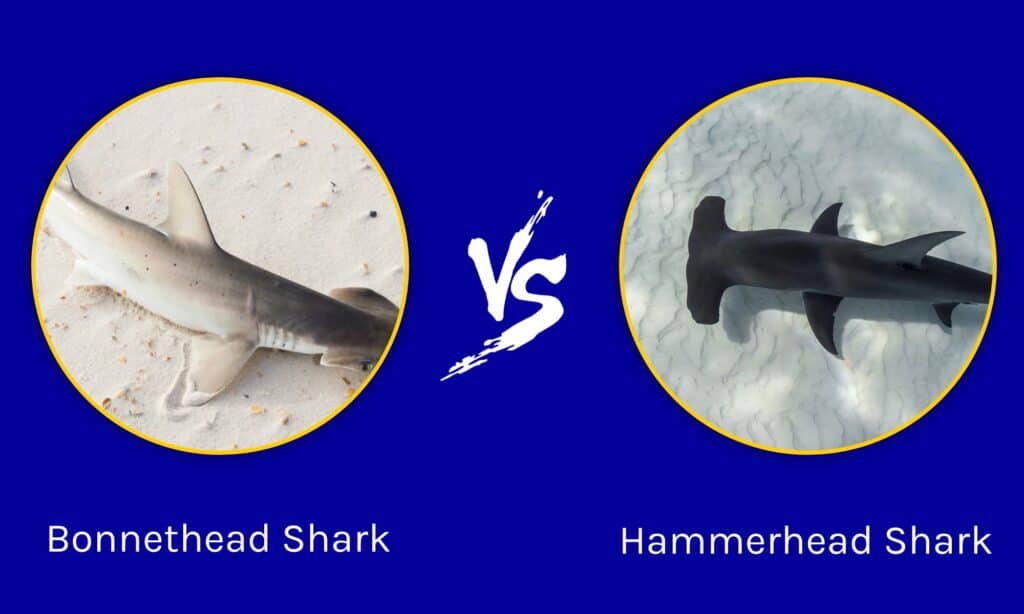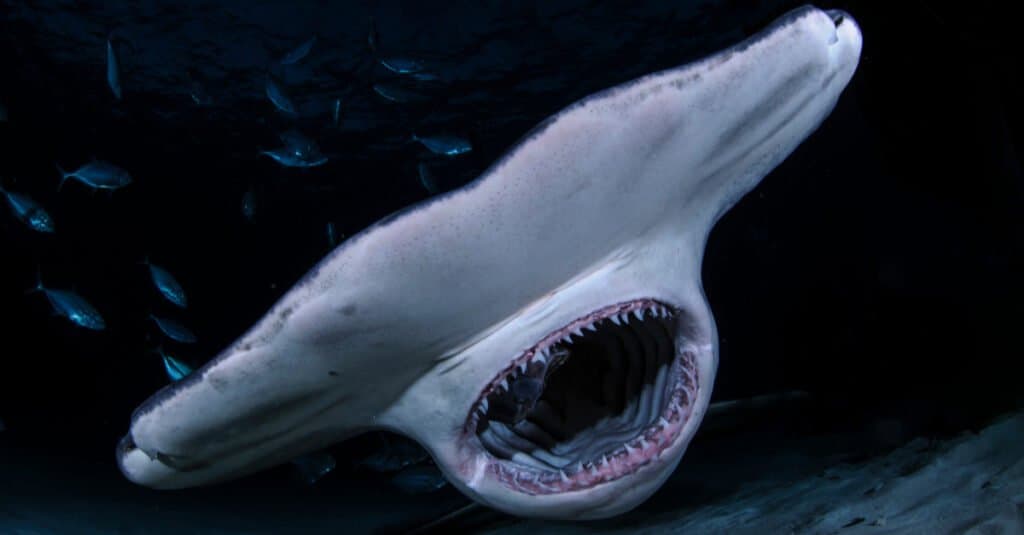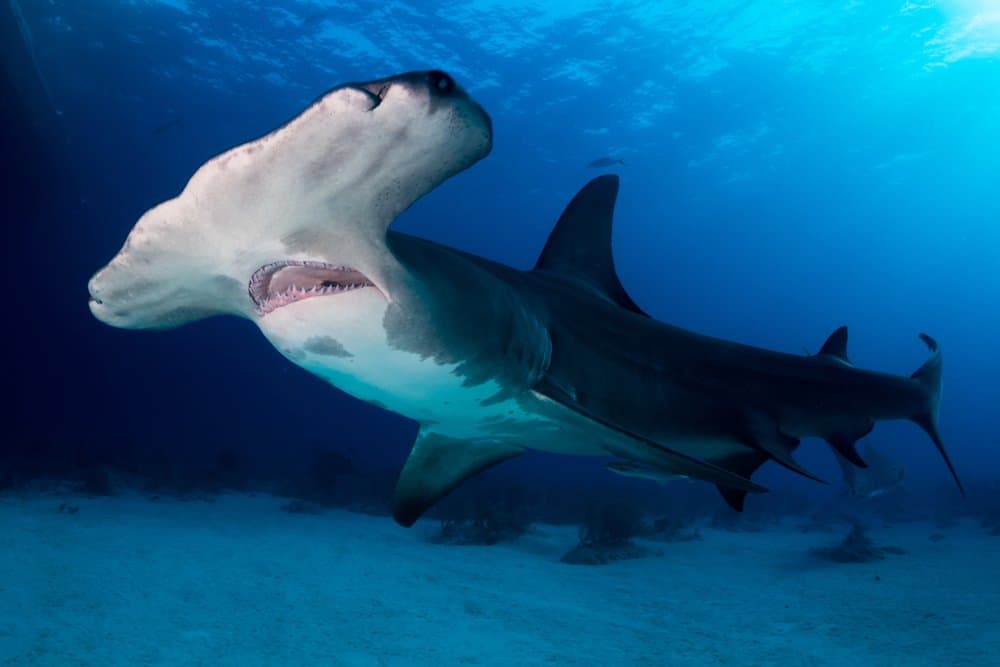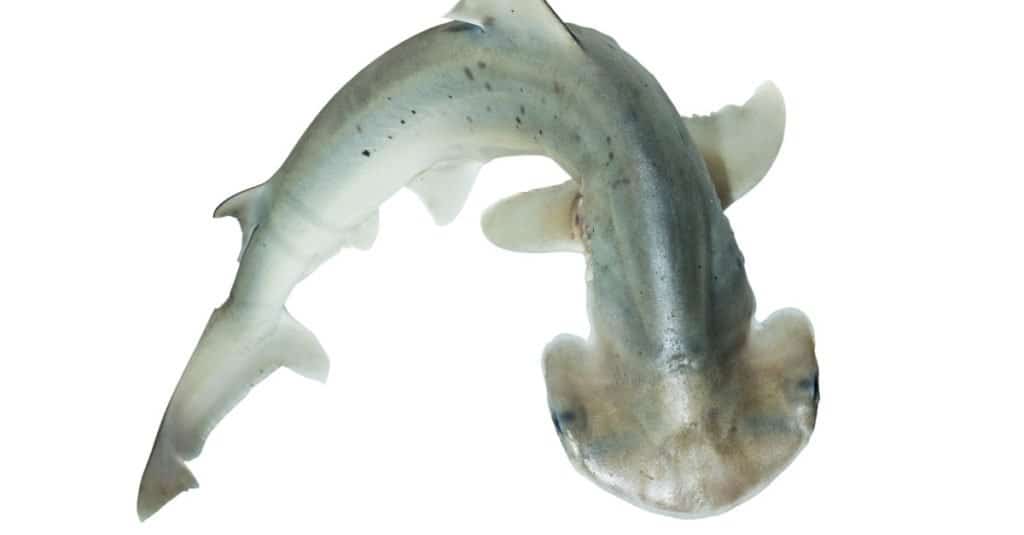When it comes to the kings of the ocean, sharks may just hold the top spot! Among the most famous sharks around are the bull shark, great white shark, and hammerhead shark. But did you know that there are many different types of hammerhead? It can be tough to identify sharks, and there is a common misconception that bonnethead sharks are a separate group entirely from hammerheads. This article will compare the two and learn once and for all the differences between bonnethead sharks and hammerhead sharks.
Comparing Bonnetheads And Hammerheads

| Bonnethead | (Great) Hammerhead | |
|---|---|---|
| Size | Length: 3-4 feet | Length: 20 feet |
| Prey | Crustaceans, crabs, shrimp, mollusks, small fish, seagrass | Crabs, lobsters, squid, tarpon, toadfish, croaker, and more |
| Distribution | Both sides of the American coast | Tropical waters between latitude lines 40°N and 37°S. Atlantic from North Carolina to Uruguay, Indian Ocean, Pacific Ocean. |
| Human Attacks | None. Too small and are generally shy. | Rare, and none were deadly. |
While it may not seem immediately clear, bonnethead sharks and hammerhead sharks are a part of the same family! Both sharks are members of the Sphyrna family, making them closely related. In fact, the bonnethead is actually a hammerhead shark itself. Within the Sphyrna family, however, are nine separate species. Of those nine, the great hammerhead shark is likely the most famous as it is the largest of them all. We are going to continue the comparison between the bonnethead and the great hammerhead.
Additionally, the two species of hammerhead inhabit different habitats, prey on different creatures, and have different relationships with humans.
Key Differences Between A Bonnethead And A Hammerhead
The key differences between a bonnethead and a great hammerhead are size, prey, distribution, and behavior to humans.
Let’s explore all of these differences in detail below.
Bonnethead vs Hammerhead: Size

Great hammerheads are the largest species of hammerhead sharks in the world.
©Martin Voeller/Shutterstock.com
When it comes to size, bonnetheads are significantly smaller. They are small, even by general shark standards. Most bonnetheads only grow to three feet in length, with some individuals reaching four feet with age. Additionally, bonnetheads have a rounder head (known as a cephalofoil) than a great hammerhead, giving them the nickname “shovelheads.” They have sexually dimorphic heads, with the males having a distinct bulge.
Great hammerheads aren’t just larger than bonnetheads; they are incredibly large fish in general. Most great hammerheads can grow to a length of 15 feet, but some individuals reach lengths of 20 feet. The cephalofoil of great hammerheads is between 23-27% of the body length and has a characteristic look that many people associate with hammerheads. Although they aren’t as commonly seen as bonnetheads, great hammerheads are what most people picture when they envision a “hammerhead shark.”
Bonnethead vs Hammerhead: Prey

Bonnetheads are the only sharks in the world known to eat plant matter.
©IrinaK/Shutterstock.com
Among sharks, bonnetheads have one of the most unique diets. Their diet is primarily made up of small crustaceans. The most common foods of the bonnethead are the blue crab, shrimp, mollusk, and small fish. They have sensory organs in their head that allows them to detect electromagnetic activity in the mud, making them great hunters even in low-visibility water and in places where prey is often buried. Part of what makes the diet of bonnetheads so unique is their ability to eat seagrass as a large portion of their diets. Bonnetheads are known as the only sharks in the world to feed on plant matter as a major source of nutrients.
Great hammerhead sharks are top predators in their environment and have no real predators outside of humans. They are known to eat invertebrates like lobsters, crabs, and squid. Their preferred prey is bony fish, including tarpon, sardines, toadfish, porgies, grunts, croakers, and even other sharks. Like bonnetheads, great hammerheads have sensory organs that allow them to sense electromagnetic currents that all living things emit.
Bonnethead vs Hammerhead: Distribution

Great hammerheads are found in most tropical waters across the world.
©HakBak/Shutterstock.com
Bonnethead sharks are native to both coasts of the American coast. They generally prefer waters that are warmer than 70 degrees. In the Atlantic Ocean, they can be found south near the coast of Brazil, through the Gulf of Mexico, and up the coast into New England. They can be found in the Pacific Ocean from southern California all the way to Peru in the south. Bonnetheads prefer sandy and muddy regions, often being caught around beds of seagrass near estuaries and bays.
Great hammerheads are much less shallow-water sharks than bonnetheads are. They can be found in almost any tropical water in the Atlantic, Indian, Pacific, and South China Seas. They generally stay near coral reefs and along continental shelves but often roam in between shallow water and deep water indiscriminately.
Bonnethead vs Hammerhead: Human Attacks

Due to their small size, bonnetheads do not bother humans.
©IrinaK/Shutterstock.com
One of the first things that humans think of when it comes to sharks is attacks. When it comes to the bonnethead, there is little danger of ever being attacked, let alone killed. These sharks are much too small to bother a human. There is a single reported case of an “unprovoked” attack, but it didn’t result in serious injury.
Great hammerheads are much larger and tend to eat larger prey, naturally making them a potential threat to humans. Still, even with their size, there have only been 16 documented attacks on humans since 1900. In short, the likelihood of getting killed by a hammerhead shark is extremely rare, especially when you consider that there haven’t been any recorded deaths out of those 16 encounters.
The photo featured at the top of this post is © Michael_19/Shutterstock.com
Thank you for reading! Have some feedback for us? Contact the AZ Animals editorial team.






